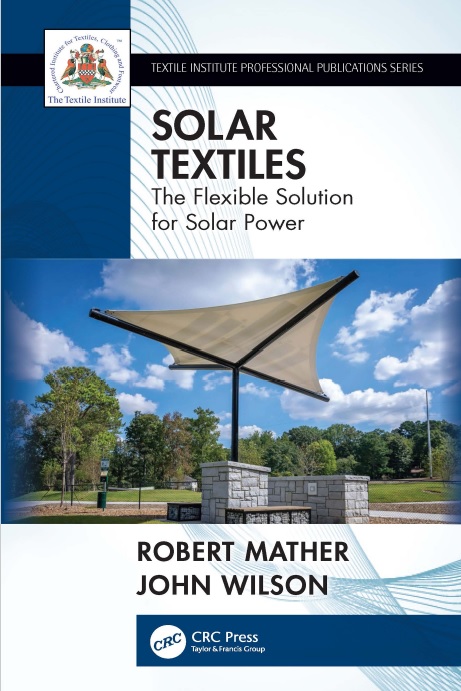Solar Textiles: The Flexible Solution for Solar Power
By Robert Mather and John Wilson

Contents:
Textile Institute Professional Publications ……………………………………………………….ix
Acknowledgements ………………………………………………………………………………………xi
Authors ……………………………………………………………………………………………………. xiii
Chapter 1 The Versatility of Textile Fabrics …………………………………………………1
Chapter 2 The Photovoltaic Effect and How It Is Used ………………………………….5
2.1 Introduction …………………………………………………………………….5
2.2 Light into Electricity ………………………………………………………..5
2.3 The Photovoltaic Effect …………………………………………………….6
2.4 Solar Cell Parameters ……………………………………………………….9
2.5 Solar Cell Materials ……………………………………………………….. 10
2.6 Constraints on Choices for Flexible PV ……………………………. 12
Chapter 3 Constructions of Textile Fabrics ………………………………………………… 15
3.1 Introduction ………………………………………………………………….. 15
3.2 Properties of Textile Fibres …………………………………………….. 16
3.3 Fabric Constructions ……………………………………………………….20
3.3.1 Woven Fabrics ……………………………………………………20
3.3.2 Knitted Fabrics …………………………………………………..22
3.3.3 Embroidery ………………………………………………………..23
3.3.4 Non-Woven Fabrics …………………………………………….25
3.4 Some Concluding Remarks ……………………………………………..26
References ………………………………………………………………………………26
Chapter 4 Strategies for Achieving Electrically Conducting Textile Fabrics …..29
4.1 Introduction …………………………………………………………………..29
4.2 Conducting Yarns …………………………………………………………..30
4.3 Conducting Fabrics ………………………………………………………… 33
4.4 Some Concluding Remarks …………………………………………….. 39
References ………………………………………………………………………………40
Chapter 5 Enabling Textile Fabrics to Become Photovoltaically Active ………… 43
5.1 Introduction ………………………………………………………………….. 43
5.2 Alternative Strategies …………………………………………………….. 43
5.2.1 Attaching Cells to a Fabric ………………………………….. 43
5.2.2 Forming PV Fibres into a Fabric …………………………..44
5.2.3 Direct Coating of PV Cells onto a Fabric ………………50
5.3 Conclusion …………………………………………………………………….54
References ………………………………………………………………………………55
Chapter 6 Technological and Design Specifications …………………………………….59
6.1 Introduction …………………………………………………………………..59
6.2 Optical Absorption …………………………………………………………59
6.3 Temperature Effects ……………………………………………………….62
6.4 Mechanical Considerations ……………………………………………..63
6.5 Washability ……………………………………………………………………63
6.6 Safety Aspects ……………………………………………………………….65
6.7 Conclusions ……………………………………………………………………66
References ………………………………………………………………………………66
Chapter 7 Manufacturing: Moving from Laboratory to Production ……………….69
7.1 Introduction …………………………………………………………………..69
7.2 Challenges for Textile Coating …………………………………………70
7.3 Coating Options for Flexible PV ………………………………………72
7.4 Environmental Impact …………………………………………………….74
7.4.1 Energy Payback Time………………………………………….74
7.4.2 Greenhouse Gas Emissions ………………………………….76
7.4.3 Decommissioning ……………………………………………….77
References ………………………………………………………………………………78
Chapter 8 Applications of Solar Textile Fabrics ………………………………………….81
8.1 Introduction …………………………………………………………………..81
8.2 Clothing ………………………………………………………………………..81
8.3 Tents and Canopies …………………………………………………………83
8.4 Tarpaulins ……………………………………………………………………..85
8.5 Architecture …………………………………………………………………..85
8.6 Agriculture ……………………………………………………………………87
8.7 Sailing …………………………………………………………………………..89
8.8 Airships ………………………………………………………………………..90
8.9 Aesthetic Aspects …………………………………………………………..92
8.10 Some Concluding Remarks ……………………………………………..94
References ………………………………………………………………………………94
Chapter 9 The Outlook for Solar Textiles …………………………………………………..97
9.1 Introduction …………………………………………………………………..97
9.2 Electrical Storage …………………………………………………………..97
9.3 Flexible Electrical Storage with Flexible PV ……………………..99
9.4 Flexible Energy Harvesting Combinations ………………………100
9.5 Integrated Systems with Sensors and Energy Provision …….102
9.6 Concluding Remarks …………………………………………………….104
References …………………………………………………………………………….105
Index ……………………………………………………………………………………………………….107
